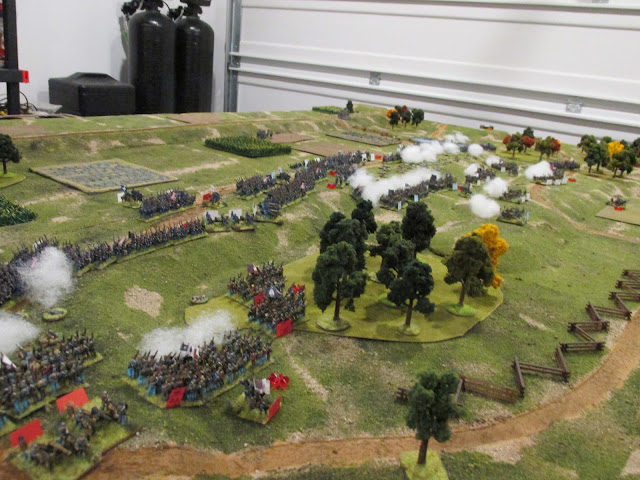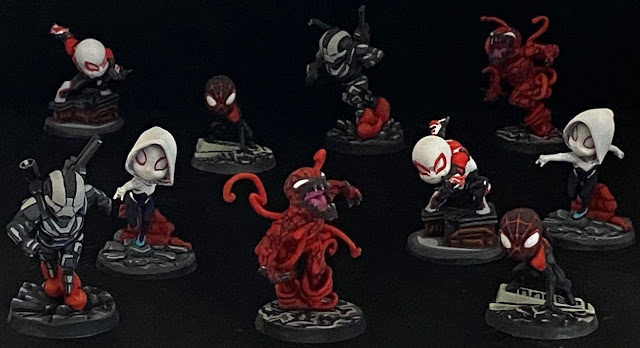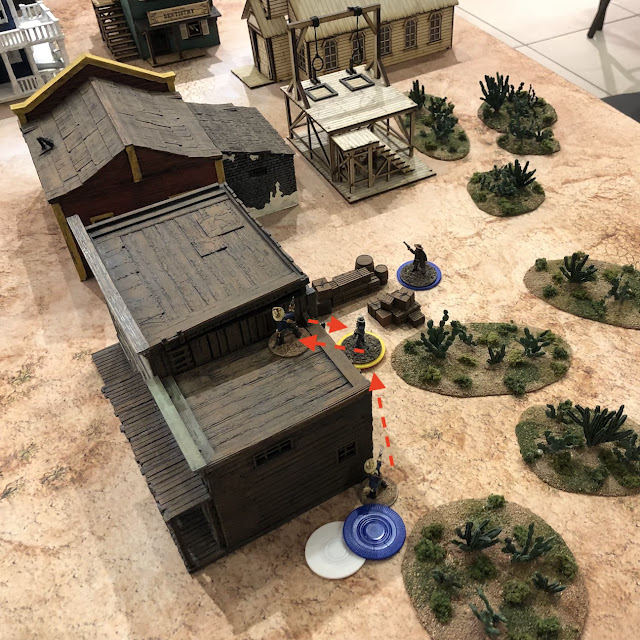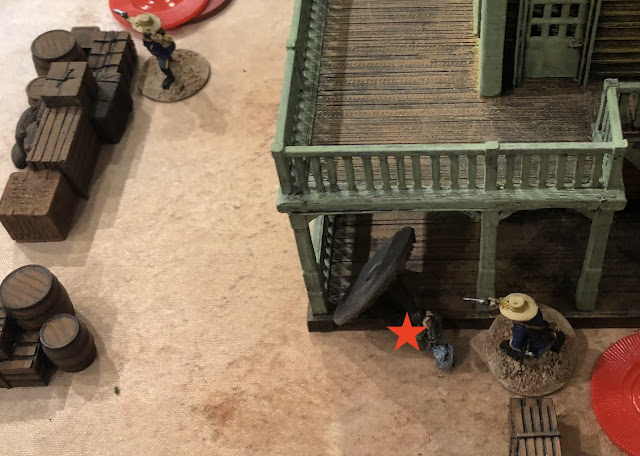Face-to-Face Gaming
Fistful of Lead
As you saw with the last blog post, I recently tried out the rules A Fistful of Lead (Reloaded), which focuses on the Old West. Although I made a hash of the rules I have since purchased A Fistful of Lead Core Rules and Fistful of Lead Fantasy: Might & Melee. The Reloaded rules are an abbreviated/simpler version of the Core Rules and does not have all of the options and nuances available to the player that the latter two do. Honestly, the differences in the core mechanics are so small, especially viewed in terms of increased page count, one wonders why Reloaded stripped them away. I hope to try these rules again with gaming buddy Bill.
Brigade Fire & Fury
I am part of a Facebook gaming group dedicated to gaming in the SE section of the state and I have always noticed that one person was always posting about the terrain boards he was making and the figures he was painting – ACW, Napoleonics, and Napoleonic-era Age of Sail – just massive amounts of work. He would invite people to come to his house and join in, but he rarely got a response. I asked him where he was and he told me a place out in the middle of nowhere about 2 1/2 hours away. (Hey, this is SE Arizona. We are all practically out in the middle of nowhere!) His games were on Friday nights at 6 PM and I could just never make it. With three hours of prep and driving that would mean I would need to leave at 3 PM. That was possible when I was working but then there would be the gaming of at least two to three hours, then another 3 hours getting back. I was thinking that would be about midnight before getting back, after a (partial) day of work. It just sounded too taxing. Now that I am retired, I decided to give it a try, only I decided to stay in a cheap motel and make the drive back the next morning.
First off, it is a nice drive there, not too bad. I drove through the city of Tucson between lunch hour and rush hour so traffic was not too bad. On the way back I took a different route (not the interstate) and it was a very nice change (for desert terrain).
The game played was a pseudo-Gettysburg battle oriented towards learning the Brigade Fire & Fury (BFF). The host is building a 12' by 6' game board for playing Gettysburg in Warlord's Epic ACW scale, which I believe is 12.5 mm. He wants to play Gettysburg soon and this was a dry run of sorts. He is also building a Waterloo game board and the corresponding forces for that. His collection was truly daunting.
It has been some time since I have read the Age of Eagles rules, the Napoleonic variant of BFF, but I slowly got the hang of the rules as the turns rolled by. As you can see from the image below, it was a fairly sizable game. We (the Union) "won" but that was because we substantially outnumbered the Confederates and our rolls to move were definitely better, so we reached the objective (the central ridge) first, forcing the enemy to charge uphill to dislodge us.
At some point the host will finish up his painting and the game board and he will do another dry run of the game. If I do it again I will have to be sure that I get a better hotel room as this game lasted four hours and my back was killing me reaching across this 6' deep board and I needed a much softer bed!
Still More Marvel United
Our Marvel United games are still chugging along every Monday night. I lost one player to pickle ball and Middle Earth Strategy Battle Game but picked up another so we still have four to six players each game night.
Here is the Loki figure that I painted. Not a powerful villain, but still interesting.
I also commissioned Spiderman 2099, Miles Morales, War Machine, Spider Ghost, and Carnage, plus a few others not in this picture to be painted by Smooth Blend Studio and I think they turned out very well. The X-Men core set is being worked on right now.
Playing Around with Laser-cut Base Designs
I have been playing around with multi-use base designs again. Right now I am working on my 6mm Napoleonics whereby each group of figured is mounted on a 1" by ½" base which slots into a large 4" wide base for use in One-Hour Wargames. I intend to add additional figures as decorations to the base. As you can see in the image below, I will place line officers at the ends of each unit, NCOs behind them, and a general and his staff in the center of the base.
 |
| Russian Napoleonic Infantry 'Brigade' |
If I were doing more of these units I think I would decrease the depth of the base so there is less empty ground between the two units and probably put the command staff at the rear.
The space showing in the upper left corner (which is actually the lower right corner when the base is facing away from you) would be were a label, specific to the rules you are using, would be affixed.
When I bought the rules Men of Bronze from Osprey I thought to myself "do I want to paint up a new set of figures (I have them in a lead pile) or do I want to take my huge DBA collection and rebase it?" I was thinking along the lines of something like this.
The idea is that I would base each figure separately, on a small base (white rectangles with a red line). When playing DBA (upper left and upper right) the number of figures per base and the base dimensions (gray rectangle with black line) would be correct. But I could then pull the individual figures out and slot them into larger individual bases (lower left) and use them for other systems.
The one catch in all of this is that one set of figures I would really like to use with this basing scheme have a beautiful basing scheme. The idea of destroying that for something lesser I would do is hard to contemplate right now.
I have been thinking about doing the same sort of scheme with my 15mm AWI figures. Currently some are based 2-3 figures on 40mm by 20mm bases, single figures on ½" square bases, and single figures on metal washers (of at least two different sizes). This scheme is sort of a 'cake and eat it too' dream.
That said, I may get rid of these figures...
My Wooden Soldiers
I have always enjoyed making my wooden soldiers. I have heard people say "that takes too long", but once you've assembled multi-part plastic models, scraped off their mould lines, and filled in the gaps you realize that making minimalist figures like mine is actually quicker. Also, having no cast details means you can paint only those details you want freehand, so it goes much quicker.
 |
| WWII British Infantry |
Every time I bring out my wooden figures, or post them in battle reports, people always remark on them. I once played in a DBA tournament with handmade wooden figures and no one refused to play against me because 'they aren't real miniatures' as I imagined they might.
I know one of the things that has stopped me from selling many of my miniatures has been that I don't want to 'lose capability', i.e. not be able to play a genre or specific ruleset because I sold my miniatures. I also find myself trying to find rules to use because I have painted miniatures and the ones they were originally painted for have fallen out of favor. (WWII and Flames of War comes to mind. I like Hail of Fire, but they keep changing because the author comes up with great new ideas.)
So my new plan is to make and paint new miniatures for the collections that I have – maybe not so many this time – and then when it is replaced with wood, sell off the metal and plastic. (It is going to be hard to part with my beautifully painted Thracians though. I may keep them just for display.)
What do you think?
Scale75 Instant Colors
As those who have read this blog for a while know I have been experimenting with Citadel Contrast Paints, Army Painter Speedpaints, and transparent acrylic inks, washes, and paints. The idea is to paint a figure white, or primer black and then dry brush gray and white to highlight (now called the 'slap chop' method), before putting on the transparent colors. I like this style but have struggled with the various products.
To date, Citadel has been the winner, but as I watch more videos I have come to realize that the manufacturer's advice on how to use all of these products – one thick coat – is not the way to really use it. Better to use thinner coats and allow the dark and light of the undercoat show this. (Called 'value sketching'.)
There are several other competing products out there, mostly because Citadel's Contrast Paints have been so wildly successful, but I have not tried them. Green Stuff World's Dipping Inks, the upcoming Express Colors from Vallejo, and Scale75's Instant Colors have all been avoided, until now.
When I saw the first videos of Instant Colors – on Scale75's YouTube channel no less – I thought the results looked absolutely horrendous. Blotchy and pale. For some reason a video popped into my feed about 'underpainting and Instant Colors' and because I am always interested to see what color people use to underpaint with – such as underpainting with pink if the color will be yellow – I decided to watch it. I was actually amazed that the final product was so good and he used Instant Colors. So I went out to a hobby shop and bought one set (8 paints for $50) to give it a try.
What I found is that you need to treat these like paints, i.e. use thin coats and not thick ones like the manufacturer suggests. Unlike Speedpaints (and many Contrast Paints) which are very saturated with one coat, Instant Colors increases saturation as you lay down more coats. The figure below shows what I mean.
 |
 |
 |
| One Coat | Two Coats | Three Coats |
Okay, they fewer the coats, the blotchier it is, but seriously, the above looks like they came from three different bottles of paint. Further, because they act as filters due to their transparency, if you use different colors on top of one another, you effectively make new colors without mixing. This document provides a really good example of what each Instant Color looks like over a specific color of primer. This has been my second most serious complaint about Speedpaints; they are too saturated and you have to thin with expensive medium to desaturate it. With Instant Colors it looks like it would be much easier to replicate the desaturated color palette from pre-industrial dyes. (That is a good resource for what colors to really use, by the way.)
So, as this is more the way I like to paint now, white base with transparent colors, followed by blacklining with inks to separate colors, Instant Colors not providing a strong contrast actually works better for me. (I went out and immediately bought a second set to test.) It will be interesting to see how this plays out on wooden figures.
Well, that is it for now. Next time, an update on one of my favorite rules, Tin Soldiers in Action and a report from a convention I will be attending. (Unfortunately not Fall-In 2022.)


















